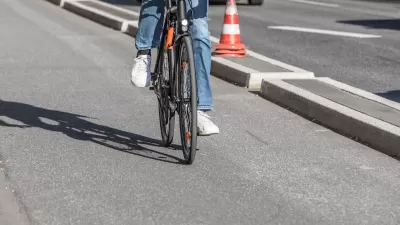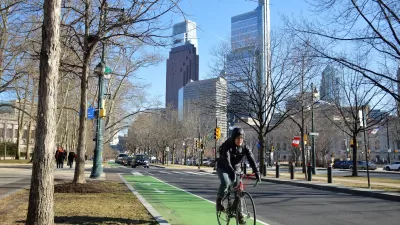A new in-house team dedicated to pedestrian safety at Cincinnati City Hall and a new complete streets ordinance are some of the changes underway in Cincinnati.

The Cincinnati City Council approved ordinance in October to create an in-house pedestrian safety crew, according to an article at the time by Anna Azallion for WCPO. The council acted to implement the new safety crew after a string of pedestrian crashes near the University of Cincinnati. The city counted 200 collisions with pedestrians in the city up until that point in 2022.
“The in-house safety crew will work on pedestrian safety projects like the installation of temporary bump-outs, signage, pain and rubber speed cushions,” according to the article.
Kea Wilson picked up the news for Streetsblog USA this month, putting the news of context of a recent groundswell of political and public support for pedestrian safety improvements in the Queen City.
The city recently more than doubled its funding for pedestrian safety initiatives as part of its 2023 budget, and adopted a Complete Streets ordinance in December that will require DOT leaders to explain themselves when they choose not to include vulnerable road user facilities in road projects; citizen-led advocacy groups have also successfully fought for significant infrastructure improvements in their neighborhoods.
Wilson speaks with Mel McVay, vision zero manager for the city, who talks about the growing support for political safety in the safety as well as what to expect from the five-person crew in the future. “Many of the most-effective pedestrian-focused projects, McVay explains, don't actually require specialized knowledge to install, because they rely on simple, easy-to-work-with materials like bolted-down plastic dividers to prevent drivers form drifting over center-lines, or high-visibility paint to make crosswalks easier for motorists to see at night,” for example.
More more information about the city’s new complete streets ordinance, see another article written by Azaillon in December. “Under the new law, the Department of Transportation and Engineering (DOTE) will have a checklist to consider before moving forward with road improvement projects,” writes Azaillon. “The list includes five categories: bike facilities, sidewalk and curb ramps, traffic calming, safety improvements and comfort enhancements. Within those categories are things like bike lanes, sidewalks and speed humps.”
FULL STORY: Cincinnati Hires Dedicated In-House Crew To Build Pedestrian Infrastructure

Planetizen Federal Action Tracker
A weekly monitor of how Trump’s orders and actions are impacting planners and planning in America.

Maui's Vacation Rental Debate Turns Ugly
Verbal attacks, misinformation campaigns and fistfights plague a high-stakes debate to convert thousands of vacation rentals into long-term housing.

San Francisco Suspends Traffic Calming Amidst Record Deaths
Citing “a challenging fiscal landscape,” the city will cease the program on the heels of 42 traffic deaths, including 24 pedestrians.

Amtrak Rolls Out New Orleans to Alabama “Mardi Gras” Train
The new service will operate morning and evening departures between Mobile and New Orleans.

The Subversive Car-Free Guide to Trump's Great American Road Trip
Car-free ways to access Chicagoland’s best tourist attractions.

San Antonio and Austin are Fusing Into one Massive Megaregion
The region spanning the two central Texas cities is growing fast, posing challenges for local infrastructure and water supplies.
Urban Design for Planners 1: Software Tools
This six-course series explores essential urban design concepts using open source software and equips planners with the tools they need to participate fully in the urban design process.
Planning for Universal Design
Learn the tools for implementing Universal Design in planning regulations.
Heyer Gruel & Associates PA
JM Goldson LLC
Custer County Colorado
City of Camden Redevelopment Agency
City of Astoria
Transportation Research & Education Center (TREC) at Portland State University
Jefferson Parish Government
Camden Redevelopment Agency
City of Claremont





























